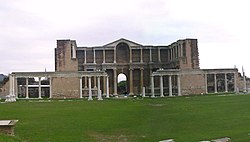Manisa: Difference between revisions
No edit summary |
m avoid redirect |
||
| Line 3: | Line 3: | ||
|photo = ManisaAglayanKayaWeepingStoneTurkey.jpg |
|photo = ManisaAglayanKayaWeepingStoneTurkey.jpg |
||
|photo size = 250 |
|photo size = 250 |
||
|photo cap = "The Weeping Rock", associated with the [[Lydia|Lydian]] princess [[Niobe]], attends Manisa from the heights of the [[ |
|photo cap = "The Weeping Rock", associated with the [[Lydia|Lydian]] princess [[Niobe]], attends Manisa from the heights of the [[Spil Mount]] ([[Mount Sipylus]]) |
||
|logo = |
|logo = |
||
|logo size = |
|logo size = |
||
| Line 63: | Line 63: | ||
== See also == |
== See also == |
||
* [[Vestel Manisaspor]] |
* [[Vestel Manisaspor]] |
||
* [[ |
* [[Spil Mount]] |
||
* [[Sultana (grape)]] |
* [[Sultana (grape)]] |
||
Revision as of 06:07, 9 October 2007
Manisa (Greek: Μαγνησία Magnesia) is the capital city of the Turkish province of Manisa. It has a population of 214,345.
History
Manisa has a far-reaching past in the Aegean region of Anatolia. Its recorded history goes back to 500 BC, but the first known (Greek) settlements date back to the 14th century BC.
In Classical times the city was known as Magnesia ad Sipylum, and was the site of many battles between Romans and Greeks. Under the Roman Empire it remained very prosperous, despite almost being destroyed by an earthquake during the reign of Tiberius.
Since the great Ottoman Sultans chose Manisa as the training ground for crown princes, there are many examples of Ottoman architecture, as well as Seljuk. The Sultan Mosque of the 16th century was built for Ayşe Sultan, mother of Kanuni Sultan Süleyman (Suleiman the Magnificent). In her honor, the Mesir Macunu Festival (featuring spiced candy, which is supposed to restore health, youth and potency, also known as "Turkish Viagra") is held every year in March, in the grounds of this mosque.
The Muradiye Mosque of the 16th century was built by the great architect Sinan (and completed by Sedefhar Mehmet Ağa), and the Murad Bey Medresse now houses the Archaeological Museum of Manisa.
Manisa celebrates the Vintage Festival every September, when the fruits of the vineyards are celebrated. The vineyards surround the city and provide dry fruit for export from İzmir, and grapes for wine making.

Modern Manisa
Modern Manisa is very much associated with the consumer electronics and white goods giant Vestel, as well as the football team Vestel Manisaspor, sponsored by the same group, although its economic base is far from being confined to the name Vestel alone.
Notable natives
- Ahmet Bilek - Olympic gold medalist in wrestling
- Demet Evgar - Actress
- Hilmi Özkök - General and former Chief of the General Staff of Turkey
- İlhan Berk - poet
- Gelenbevi Ismail Efendi - Ottoman mathematician and academics
- Kenan Evren - General, military coup leader and 7th President of Turkey
- Ruhi Sarıalp - Olympic bronze medalist in triple jump
- Sinan Erdem - former volleyball player and head of Turkish National Olympic Committee
See also
External links
- Celal Bayar University
- Jewish community of Manisa
- Selendi is a town and a district of Manisa Province
- MANİSA Gölmarmara ESELER (İsalar) Village


